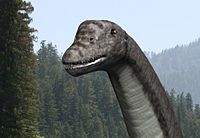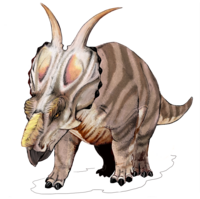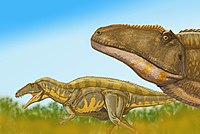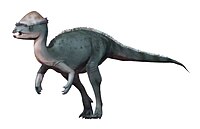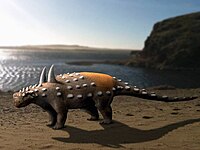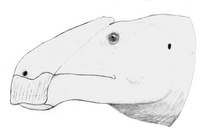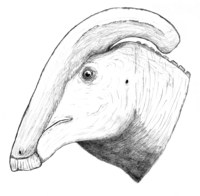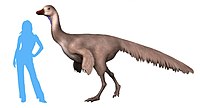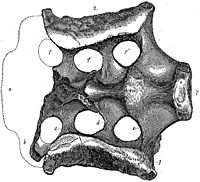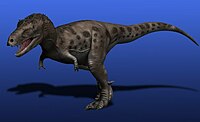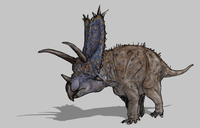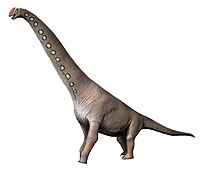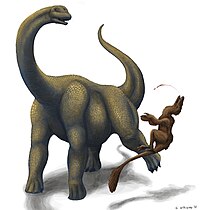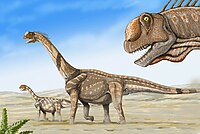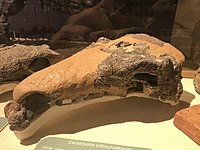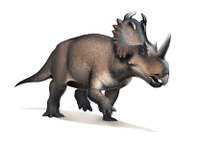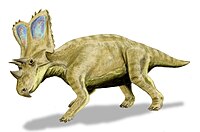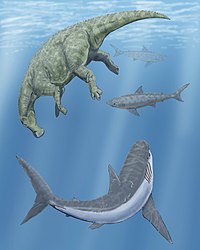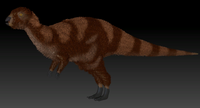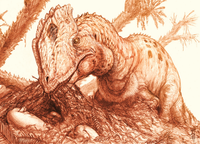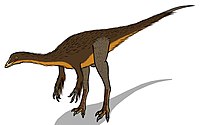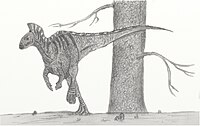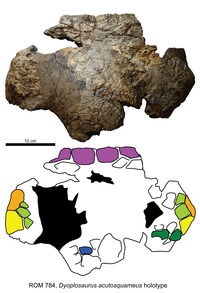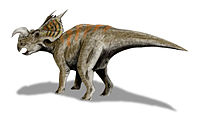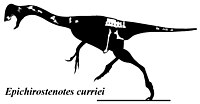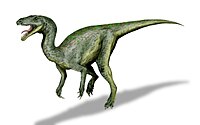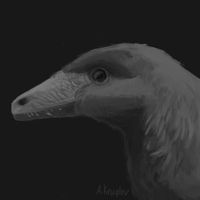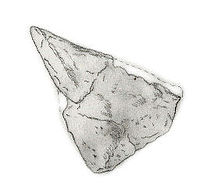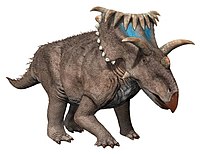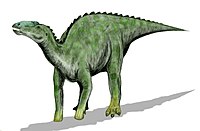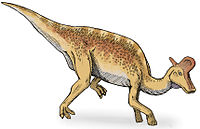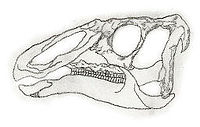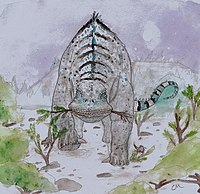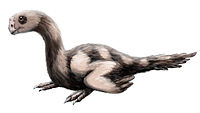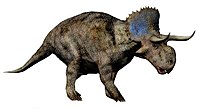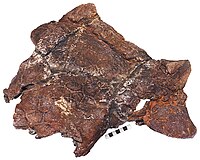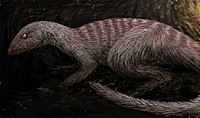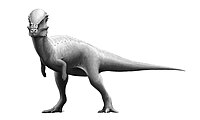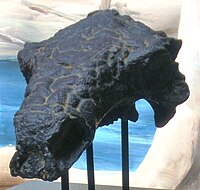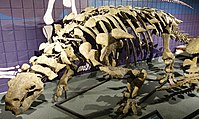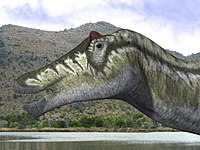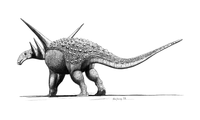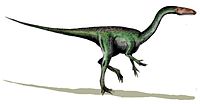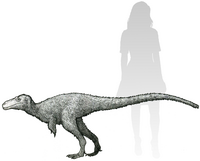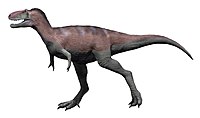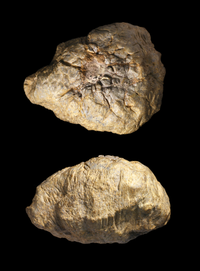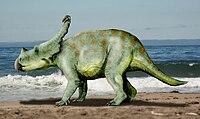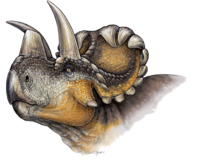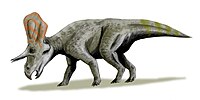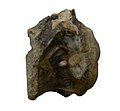List of North American dinosaurs
This is a list of dinosaurs whose remains have been recovered from North America. North America has a rich dinosaur fossil record with great diversity of dinosaurs.
History
[edit]The earliest potential record of dinosaurs in North America comes from rare, unidentified (possibly theropod) footprints in the Middle-Late Triassic Pekin Formation of North Carolina.[1] However, the most reliable early record of North American dinosaurs comes from fragmentary saurischian fossils unearthed from the Upper Triassic Dockum Group of Texas.[2] Later in the Triassic period, dinosaurs left more recognizable remains, and could be identified as specific genera. Examples of later Triassic North American dinosaur genera include Coelophysis, Chindesaurus, Gojirasaurus, and Tawa. Fossils of Tawa-like dinosaurs have also been found in South America, which has important indications about paleogeography. During the Early Jurassic Period, dinosaurs such as Dilophosaurus, Anchisaurus, Coelophysis (formerly known as Megapnosaurus), and the early thyreophoran Scutellosaurus lived in North America. The latter is believed to have been the ancestor of all stegosaurs and ankylosaurs. The Middle Jurassic is the only poorly represented time period in North America, although several Middle Jurassic localities are known from Mexico. Footprints, eggshells, teeth, and fragments of bone representing theropods, sauropods, and ornithopods have been found, but none of them are diagnostic to the genus level.
The Late Jurassic of North America, however, is the exact opposite of the Middle Jurassic. The Late Jurassic Morrison Formation is found in several U.S. states, including Colorado, Utah, Wyoming, Montana, New Mexico, Oklahoma, South Dakota, and Texas. It is notable as being the most fertile single source of dinosaur fossils in the world. The roster of dinosaurs from the Morrison is impressive. Among the theropods, Allosaurus, Saurophaganax, Torvosaurus, Ceratosaurus, Coelurus, Ornitholestes, Tanycolagreus, Stokesosaurus, and Marshosaurus are found in the Morrison. An abundance of sauropods has been found there, including Apatosaurus, Diplodocus, Barosaurus, Brachiosaurus, Camarasaurus, Brontosaurus and Amphicoelias. Three genera of stegosaurs, Alcovasaurus, Stegosaurus and Hesperosaurus, have been found there. Finally, ornithopods found in the Morrison include Camptosaurus, Dryosaurus, and Nanosaurus,
During the Early Cretaceous, new dinosaurs evolved to replace the old ones. Sauropods were still present, but they were not as diverse as they were in the Jurassic Period. Theropods from the Early Cretaceous of North America include dromaeosaurids such as Deinonychus and Utahraptor, the carnosaur Acrocanthosaurus, and the coelurosaur Microvenator. Sauropods included Astrodon, Brontomerus, and Sauroposeidon. Ornithischians were more diverse than they were in the Jurassic PerTenontosaurus,Dakotadon,hoplitosaurus are some of the ornithopods that lived during this time period. Ankylosaurs replaced their stegosaur cousins in the Cretaceous. Ankylosaurs from the Early Cretaceous of North America include Sauropelta and Gastonia. Therizinosaurs such as Falcarius are also known from the Early Cretaceous of North America.
Finally, during the Late Cretaceous Period, dinosaurs continued to diversify, with the Cenomanian stage seeing the rise of hadrosaurs such as Eolambia, and Protohadros, as well tyrannosaurs such as Moros intrepidus, which would eventually replace the carnosaurs, like Siats, as the continent’s apex predators. These groups continued to thrive into the Turonian stage, in which therizinosaurs like Nothronychus and larger ceratopsians such as Zuniceratops lived. During the Campanian stage of the Late Cretaceous, an enormous diversity of dinosaurs is known. Theropods included the tyrannosaurs Albertosaurus, Gorgosaurus, Daspletosaurus, Teratophoneus, Bistahieversor, and Appalachiosaurus, and the dromaeosaurids Dromaeosaurus, Saurornitholestes, Atrociraptor, and Bambiraptor. Ceratopsians, such as Pachyrhinosaurus, Styracosaurus, Centrosaurus, Monoclonius, Brachyceratops and Pentaceratops also existed. Among hadrosaurs, Hypacrosaurus, Gryposaurus, Kritosaurus, Parasaurolophus, Corythosaurus, Lambeosaurus and Prosaurolophus existed. During the latest Cretaceous, the Maastrichtian age, the diversity of dinosaurs saw a decline from the preceding Campanian stage. North American herbivorous dinosaurs from this time period include the titanosaur sauropod Alamosaurus, the ceratopsians Bravoceratops, Regaliceratops, Triceratops, Leptoceratops, Torosaurus, Nedoceratops, Tatankaceratops (the latter two possible species of Triceratops), and Ojoceratops, the pachycephalosaurs Pachycephalosaurus, Stygimoloch, Dracorex, and Sphaerotholus, the hadrosaurs Augustynolophus, Saurolophus and Edmontosaurus, the ornithopod Thescelosaurus the ankylosaur Ankylosaurus and the nodosaurs Denversaurus, Glyptodontopelta and Edmontonia. Predatory dinosaurs from this time period included the tyrannosaurids Tyrannosaurus, Nanotyrannus (which may just be a juvenile of the former) and Dryptosaurus, the ornithomimids Ornithomimus, Dromiceiomimus, Struthiomimus, the oviraptorids Anzu, Leptorhynchos and Ojoraptorsaurus, the troodontids Pectinodon, Paronychodon and Troodon, the coelurosaur Richardoestesia and the dromaeosaurs Acheroraptor and Dakotaraptor.
The only recorded find of a dinosaur fossil in Central America consists of a single femur discovered from Middle Cretaceous age deposits in Comayagua Department in the central part of Honduras. The fossil had been found in January, 1971 by Bruce Simonson and Gregory Horne, though it was later sent to the National Museum of Natural History, USA where it is deposited under catalogue number USNM PAL 181339. The discovery was not formally described until 1994 where it was identified as the femur of a small hadrosaur or iguanodontid, probably the former.[3] The first report of a dinosaur from Central America ever however was a newspaper article published in August of 1933 by Canada's Montreal Gazette, though the story was picked up by several American newspapers. The fossil was an isolated metatarsus that had been collected by University of Pennsylvania explorer George Mason from woods near Olanchito, Honduras, though a vertebra was also mentioned to be found by locals. The bones have since been lost and their true identity remains indeterminable.[4]
Criteria for inclusion
[edit]- The genus must appear on the List of dinosaur genera.
- At least one named species of the creature must have been found in North America.
- This list is a complement to Category:Mesozoic dinosaurs of North America.
List of North American dinosaurs
[edit]Valid genera
[edit]Invalid and potentially valid genera
[edit]- Agathaumas sylvestris: Most well known from a painting by Charles Knight. It may have been a synonym of Triceratops, but without cranial remains, this cannot be confirmed.
- Alcovasaurus longispinus: Although originally named as a species of Stegosaurus, it may actually be a species of the otherwise European Miragaia.
- Antrodemus valens: May represent the same animal as Allosaurus; if so, the name Antrodemus would have priority. However, because it is based on undiagnostic remains of uncertain provenance, this cannot be confirmed.
- Apatodon mirus: Its holotype was originally believed to be the jawbone of a Mesozoic pig, but has been reinterpreted as a dinosaur vertebra. What type of dinosaur it belonged to is unknown, but there have been suggestions that it was from Allosaurus.
- "Beelemodon": Known only from two teeth found in Wyoming. They share features of compsognathids, dromaeosaurids, and basal oviraptorosaurs.
- "Capitalsaurus": The official dinosaur of the District of Columbia. It is known from a single vertebra discovered at the intersection of First and F Streets S.E., which is now appropriately named "Capitalsaurus Court".
- Cathetosaurus lewisi: Usually seen as a species of Camarasaurus, but an unpublished study argues that it might be a distinct genus.
- Claorhynchus trihedrus: An indeterminate cerapod that may be either a hadrosaurid or a ceratopsid, in which case it may be a synonym of Triceratops.
- "Coelosaurus" antiquus: The generic name is said to be preoccupied, but its namesake remains obscure.
- "Comanchesaurus kuesi": Only named in a dissertation. It has been described as a possible indeterminate saurischian.
- Deinodon horridus: Only known from teeth. Several referred teeth have since been found to belong to already known species, and the holotype could itself belong to Gorgosaurus.
- Dracorex hogwartsia: Described as a small, flat-headed pachycephalosaur. However, it is likely that it is just a juvenile Pachycephalosaurus.
- Drinker nisti: May be a synonym of Nanosaurus.
- Epanterias amplexus: Possibly a large specimen of Allosaurus, but it may be a different taxon due to its younger age.
- Latenivenatrix mcmasterae: The largest known troodontid. It is sometimes suggested to be synonymous with Stenonychosaurus, which its remains were originally assigned to.
- "Magulodon muirkirkensis": Only known from a single tooth that may belong to either an ornithopod or a basal ceratopsian.
- "Microcephale": Said to be an extremely small pachycephalosaur, with skull caps only 5 centimetres (2.0 in) long.
- Mojoceratops perifania: May be a species of specimen of Chasmosaurus.
- Nanotyrannus lancensis: Described as a small adult tyrannosaur, although it is more likely to be a juvenile Tyrannosaurus rex.
- Nedoceratops hatcheri: Due to its lack of a nasal horn, it has been named "Diceratops" (which is preoccupied by an insect) and Diceratus. However, it may simply be an unusual specimen of Triceratops.
- Ojoceratops fowleri: May be ancestral to Triceratops or a synonym of Eotriceratops.
- "Orcomimus": Potentially referrable to any of the ornithomimosaur taxa known from the Hell Creek Formation.
- Othnielia rex: Only known from an undiagnostic femur, but it may have belonged to Nanosaurus anyway.
- Othnielosaurus consors: Most likely a synonym of Nanosaurus.
- Palaeopteryx thomsoni: Known from a few very small bones which could belong to either a bird or a small bird-like dinosaur.
- Protoavis texensis: Described as a Triassic bird but is more likely a chimera consisting of elements from various unrelated tetrapods.
- Rhinorex condrupus: Phylogenetic analysis shows that it may fall within Gryposaurus, and thus be a junior synonym of that genus.
- Rubeosaurus ovatus: Likely a species of Styracosaurus, or even simply an unusual specimen of S. albertensis.
- Stygimoloch spinifer: Had a short skull dome with long horns jutting out from behind it. It is usually thought to be a subadult Pachycephalosaurus, but has been noted to be stratigraphically younger.
- Tatankaceratops sacrisonorum: Noted to possess a strange mix of features of both juvenile and adult Triceratops. It may be a dwarf specimen of that genus or an individual that stopped growing prematurely.
Timeline
[edit]This is a timeline of selected dinosaurs from the list above. Time is measured in Ma, megaannum, along the x-axis.

See also
[edit]- List of Appalachian dinosaurs - for dinosaurs specifically known from the former landmass of Appalachia (where much of eastern North America is now)
References
[edit]- ^ HUBER, P. (1998). The oldest Late Triassic footprint assemblage from North America (Pekin Formation, Deep River Basin, North Carolina, USA). Southeastern Geology, 38(2), 77-90.
- ^ Sarıgül, Volkan (2018-11-17). "New archosauromorph fragments from the Dockum Group of Texas and assessment of the earliest dinosaurs in North America". Historical Biology. 30 (8): 1059–1075. doi:10.1080/08912963.2017.1333609. ISSN 0891-2963. S2CID 134371261.
- ^ Horne, Gregory S. (1994-03-31). "A mid-Cretaceous ornithopod from central Honduras". Journal of Vertebrate Paleontology. 14 (1): 147–150. Bibcode:1994JVPal..14..147H. doi:10.1080/02724634.1994.10011548. ISSN 0272-4634.
- ^ "HONDURAS AND THE DINOSAURS - Escuela de Biología". biologia.unah.edu.hn (in Spanish). Retrieved 2022-07-29.
- ^ Longrich, Nicholas R.; Suberbiola, Xabier Pereda; Pyron, R. Alexander; Jalil, Nour-Eddine (2021). "The first duckbill dinosaur (Hadrosauridae: Lambeosaurinae) from Africa and the role of oceanic dispersal in dinosaur biogeography". Cretaceous Research. 120: 104678. Bibcode:2021CrRes.12004678L. doi:10.1016/j.cretres.2020.104678. S2CID 228807024.
- ^ Fowler, D. W.; Sullivan, R. M. (2011). "The First Giant Titanosaurian Sauropod from the Upper Cretaceous of North America". Acta Palaeontologica Polonica. 56 (4): 685. CiteSeerX 10.1.1.694.3759. doi:10.4202/app.2010.0105. S2CID 53126360.
- ^ Longrich, Nicholas R.; Currie, Philip J. (2009). "Albertonykus borealis, a new alvarezsaur (Dinosauria: Theropoda) from the Early Maastrichtian of Alberta, Canada: Implications for the systematics and ecology of the Alvarezsauridae". Cretaceous Research. 30 (1): 239–252. Bibcode:2009CrRes..30..239L. doi:10.1016/j.cretres.2008.07.005.
- ^ Eberth, David A.; Currie, Philip J. (2010). "Stratigraphy, sedimentology, and taphonomy of the Albertosaurus bonebed (upper Horseshoe Canyon Formation; Maastrichtian), southern Alberta, Canada". Canadian Journal of Earth Sciences. 47 (9): 1119–1143. Bibcode:2010CaJES..47.1119E. doi:10.1139/e10-045.
- ^ Tykoski, Ronald S.; Contreras, Dori L.; Noto, Christopher (2023-10-13). "The first small-bodied ornithopod dinosaur from the Lewisville Formation (middle Cenomanian) of Texas". Journal of Vertebrate Paleontology. doi:10.1080/02724634.2023.2257238. ISSN 0272-4634.
- ^ Prieto-Márquez, A. 2014. "Skeletal morphology of Kritosaurus navajovius (Dinosauria:Hadrosauridae) from the Late Cretaceous of the North American south-west, with an evaluation of the phylogenetic systematics and biogeography of Kritosaurini". Journal of Systematic Palaeontology 12(2): 133-175
- ^ Smith, Nathan (1820). "Fossil bones found in red sandstones". American Journal of Science. 2: 146–147.
- ^ Prieto-Márquez, Albert; Wagner, Jonathan R.; Lehman, Thomas (2020). "An unusual 'shovel-billed' dinosaur with trophic specializations from the early Campanian of Trans-Pecos Texas, and the ancestral hadrosaurian crest". Journal of Systematic Palaeontology. 18 (6): 461–498. doi:10.1080/14772019.2019.1625078. S2CID 202018197.
- ^ Taylor, M.P. (2010). "Sauropod dinosaur research: a historical review." Pp. 361-386 in Moody, R.T.J., Buffetaut, E., Naish, D. and Martill, D.E. (eds.), Dinosaurs and Other Extinct Saurians: A Historical Perspective. London: The Geological Society, Special Publication No. 34.
- ^ a b c Tschopp, E.; Mateus, O. V.; Benson, R. B. J. (2015). "A specimen-level phylogenetic analysis and taxonomic revision of Diplodocidae (Dinosauria, Sauropoda)". PeerJ. 3: e857. doi:10.7717/peerj.857. PMC 4393826. PMID 25870766.
- ^ McKeown, Matthew; Brusatte, Stephen L.; Williamson, Thomas E.; Schwab, Julia A.; Carr, Thomas D.; Butler, Ian B.; Muir, Amy; Schroeder, Katlin; Espy, Michelle A.; Hunter, James F.; Losko, Adrian S. (2020). "Neurosensory and Sinus Evolution as Tyrannosauroid Dinosaurs Developed Giant Size: Insight from the Endocranial Anatomy of Bistahieversor sealeyi" (PDF). The Anatomical Record. 303 (4): 1043–1059. doi:10.1002/ar.24374. hdl:20.500.11820/8c657729-91df-4f7c-bca5-b9c469781768. ISSN 1932-8494. PMID 31967416. S2CID 210871038.
- ^ G. F. Funston & P. J. Currie (2020) New material of Chirostenotes pergracilis (Theropoda, Oviraptorosauria) from the Campanian Dinosaur Park Formation of Alberta, Canada, Historical Biology, doi:10.1080/08912963.2020.1726908
- ^ Foster, J. (2007). "Camptosaurus dispar." Jurassic West: The Dinosaurs of the Morrison Formation and Their World. Indiana University Press. p. 219-221.
- ^ Sanders, F.; Manley, K.; Carpenter, K. (2001). "Gastroliths from the Lower Cretaceous sauropod Cedarosaurus weiskopfae". In Tanke, Darren; Carpenter, Ken (eds.). Mesozoic Vertebrate Life: New Research Inspired by the Paleontology of Philip J. Currie. Indiana University Press. pp. 166–180. ISBN 0-253-33907-3.
- ^ D.A. Eberth, D.B. Brinkman, V. Barkas, "A centrosaurine mega-bonebed from the Upper Cretaceous of southern Alberta: Implications for behaviour and death events" in New Perspectives on Horned Dinosaurs: The Ceratopsian Symposium at the Royal Tyrrell Museum, September 2007 (2010).
- ^ Novas, Fernando E.; Agnolin, Federico L.; Ezcurra, Martín D.; Temp Müller, Rodrigo; Martinelli, Agustín G.; Langer, Max C. (October 2021). "Review of the fossil record of early dinosaurs from South America, and its phylogenetic implications". Journal of South American Earth Sciences. 110: 103341. Bibcode:2021JSAES.11003341N. doi:10.1016/j.jsames.2021.103341.
- ^ Therrien, François; Zelenitsky, Darla K.; Tanaka, Kohei; Voris, Jared T.; Erickson, Gregory M.; Currie, Philip J.; Debuhr, Christopher L.; Kobayashi, Yoshitsugu (2023). "Exceptionally preserved stomach contents of a young tyrannosaurid reveal an ontogenetic dietary shift in an iconic extinct predator". Science Advances. 9 (49): eadi0505. Bibcode:2023SciA....9I.505T. doi:10.1126/sciadv.adi0505. PMC 10846869. PMID 38064561.
- ^ Cau, Andrea; Brougham, Tom; Naish, Darren (2015). "The phylogenetic affinities of the bizarre Late Cretaceous Romanian theropod Balaur bondoc (Dinosauria, Maniraptora): Dromaeosaurid or flightless bird?". PeerJ. 3: e1032. doi:10.7717/peerj.1032. PMC 4476167. PMID 26157616.
- ^ Jasinski, Steven E.; Sullivan, Robert M.; Dodson, Peter (2020-03-26). "New Dromaeosaurid Dinosaur (Theropoda, Dromaeosauridae) from New Mexico and Biodiversity of Dromaeosaurids at the end of the Cretaceous". Scientific Reports. 10 (1): 5105. Bibcode:2020NatSR..10.5105J. doi:10.1038/s41598-020-61480-7. ISSN 2045-2322. PMC 7099077. PMID 32218481.
- ^ Warshaw, Elías A.; Fowler, Denver W. (2022). "A transitional species of Daspletosaurus Russell, 1970 from the Judith River Formation of eastern Montana". PeerJ. 10. e14461. doi:10.7717/peerj.14461. PMC 9703990. PMID 36452080.
- ^ a b Scherer, Charlie Roger; Voiculescu-Holvad, Christian (2024). "Re-analysis of a dataset refutes claims of anagenesis within Tyrannosaurus-line tyrannosaurines (Theropoda, Tyrannosauridae)". Cretaceous Research. 155. 105780. doi:10.1016/j.cretres.2023.105780. ISSN 0195-6671.
- ^ Bakker, R.T. (1988). "Review of the Late Cretaceous nodosauroid Dinosauria: Denversaurus schlessmani, a new armor-plated dinosaur from the Latest Cretaceous of South Dakota, the last survivor of the nodosaurians, with comments on Stegosaur-Nodosaur relationships". Hunteria 1(3): 1-23.(1988).
- ^ Jasinski, S. E.; Sullivan, R. M.; Dodson, P. (2020). "New Dromaeosaurid Dinosaur (Theropoda, Dromaeosauridae) from New Mexico and Biodiversity of Dromaeosaurids at the end of the Cretaceous". Scientific Reports. 10 (1): 5105. Bibcode:2020NatSR..10.5105J. doi:10.1038/s41598-020-61480-7. ISSN 2045-2322. PMC 7099077. PMID 32218481.
- ^ Myhrvold, Nathan P. (1997). "Supersonic sauropods? Tail dynamics in the diplodocids" (PDF). Paleobiology. 23 (4): 393–409. Bibcode:1997Pbio...23..393M. doi:10.1017/S0094837300019801. S2CID 83696153.
- ^ Conti S, Tschopp E, Mateus O, Zanoni A, Masarati P, Sala G (2022). "Multibody analysis and soft tissue strength refute supersonic dinosaur tail". Scientific Reports. 12 (1). 19245. doi:10.1038/s41598-022-21633-2. PMC 9732322. PMID 36482175.
- ^ Galton, Peter M.; Jensen, James A. (1973). "Small bones of the hypsilophodontid dinosaur Dryosaurus altus from the Upper Jurassic of Colorado". The Great Basin Naturalist. 33 (22): 129–132. JSTOR 41711378.
- ^ Arbour, V. M.; Burns, M. E.; Sissons, R. L. (2009). "A redescription of the ankylosaurid dinosaur Dyoplosaurus acutosquameus Parks, 1924 (Ornithischia: Ankylosauria) and a revision of the genus". Journal of Vertebrate Paleontology. 29 (4): 1117. Bibcode:2009JVPal..29.1117A. doi:10.1671/039.029.0405. S2CID 85665879.
- ^ Prieto-Marquez, Albert; Erickson, Gregory M.; Ebersole, Jun A. (2016). "A primitive hadrosaurid from southeastern North America and the origin and early evolution of 'duck-billed' dinosaurs". Journal of Vertebrate Paleontology. 36 (2): e1054495. Bibcode:2016JVPal..36E4495P. doi:10.1080/02724634.2015.1054495. S2CID 86032549.
- ^ Coombs W. (1972). "The Bony Eyelid of Euoplocephalus (Reptilia, Ornithischia)". Journal of Paleontology. 46 (5): 637–50. JSTOR 1303019..
- ^ Arbour, V. M.; Evans, D. C. (2019). "A new leptoceratopsid dinosaur from Maastrichtian-aged deposits of the Sustut Basin, northern British Columbia, Canada". PeerJ. 7: e7926. doi:10.7717/peerj.7926. PMC 6842559. PMID 31720103.
- ^ Dalman, S.G. (2014). "New data on small theropod dinosaurs from the Upper Jurassic Morrison Formation of Como Bluff, Wyoming, USA" (PDF). Volumina Jurassica. 12 (2): 181–196.
- ^ Butler, Richard J.; Galton, Peter M.; Porro, Laura B.; Chiappe, Luis M.; Henderson, D. M.; Erickson, Gregory M. (2010). "Lower limits of ornithischian dinosaur body size inferred from a new Upper Jurassic heterodontosaurid from North America". Proceedings of the Royal Society B. 277 (1680): 375–381. doi:10.1098/rspb.2009.1494. PMC 2842649. PMID 19846460.
- ^ Kinneer, B.; Carpenter, K.; Shaw, A. (2016). "Redescription of Gastonia burgei (Dinosauria: Ankylosauria, Polacanthidae), and description of a new species". Neues Jahrbuch für Geologie und Paläontologie - Abhandlungen. 282 (1): 37–80. doi:10.1127/njgpa/2016/0605.
- ^ Nicolás E. Campione; Kirstin S. Brink; Elizabeth A. Freedman; Christopher T. McGarrity; David C. Evans (2012). "Glishades ericksoni, an indeterminate juvenile hadrosaurid from the Two Medicine Formation of Montana: implications for hadrosauroid diversity in the latest Cretaceous (Campanian-Maastrichtian) of western North America". Palaeobiodiversity and Palaeoenvironments. in press. doi:10.1007/s12549-012-0097-1. S2CID 128568454.
- ^ Nesbitt, Irmis and Parker (2007). "A critical re-evaluation of the Late Triassic dinosaur taxa of North America." Journal of Systematic Palaeontology, 5 (#2): 209–243.
- ^ Dyer, Aaron D.; Powers, Mark J.; Currie, Philip J. (2023). "Problematic putative pachycephalosaurids: Synchrotron µCT imaging shines new light on the anatomy and taxonomic validity of Gravitholus albertae from the Belly River Group (Campanian) of Alberta, Canada". Vertebrate Anatomy Morphology Palaeontology. 10 (1): 65–110. doi:10.18435/vamp29388. ISSN 2292-1389.
- ^ Lull, Richard Swann; Wright, Nelda E. (1942). Hadrosaurian Dinosaurs of North America. Geological Society of America Special Paper 40. Geological Society of America. pp. 110–117.
- ^ Saitta, E.T. (2015). "Evidence for Sexual Dimorphism in the Plated Dinosaur Stegosaurus mjosi (Ornithischia, Stegosauria) from the Morrison Formation (Upper Jurassic) of Western USA". PLOS ONE. 10 (4). e0123503. Bibcode:2015PLoSO..1023503S. doi:10.1371/journal.pone.0123503. PMC 4406738. PMID 25901727.
- ^ Angel Alejandro Ramírez-Velasco; Mouloud Benammi; Albert Prieto-Márquez; Jesús Alvarado Ortega; René Hernández-Rivera (2012). "Huehuecanauhtlus tiquichensis, a new hadrosauroid dinosaur (Ornithischia: Ornithopoda) from the Santonian (Late Cretaceous) of Michoacán, Mexico". Canadian Journal of Earth Sciences. 49 (2): 379–395. Bibcode:2012CaJES..49..379R. doi:10.1139/e11-062.
- ^ Galton, P.M. (2010). "Species of plated dinosaur Stegosaurus (Morrison Formation, Late Jurassic) of western USA: new type species designation needed". Swiss Journal of Geosciences. 103 (2): 187–198. doi:10.1007/s00015-010-0022-4. S2CID 140688875.
- ^ Zanno, Lindsay E.; Gates, Terry A.; Ayrahami, Haviv M.; Tucker, Ryan T.; Makovicky, Peter J. (2023). "An early-diverging iguanodontian (Dinosauria: Rhabdodontomorpha) from the Late Cretaceous of North America". PLOS ONE. 18 (6). e0286042. doi:10.1371/journal.pone.0286042. PMC 10246810. PMID 37285376.
- ^ a b John A. Whitlock; Jeffrey A. Wilson Mantilla (2020). "The Late Jurassic sauropod dinosaur 'Morosaurus' agilis Marsh, 1889 reexamined and reinterpreted as a dicraeosaurid". Journal of Vertebrate Paleontology. 40 (6): e1780600. Bibcode:2020JVPal..40E0600W. doi:10.1080/02724634.2020.1780600.
- ^ Ángel Alejandro Ramírez-Velascoa; Jesús Alvarado-Ortega; Espinosa-Arrubarrena (2021). "Review of the taxonomic affinities of Latirhinus uitstlani, an emblematic Mexican hadrosaurid". Journal of South American Earth Sciences. 110: 103391. Bibcode:2021JSAES.11003391R. doi:10.1016/j.jsames.2021.103391.
- ^ Serrano-Brañas, Claudia Inés; Prieto-Márquez, Albert (2022). "Taphonomic attributes of the holotype of the lambeosaurine dinosaur Latirhinus uitstlani from the late Campanian of Mexico: Implications for its phylogenetic systematics". Journal of South American Earth Sciences. 114: 103689. Bibcode:2022JSAES.11403689S. doi:10.1016/j.jsames.2021.103689.
- ^ Varriale, Frank (2016). "Dental microwear reveals mammal-like chewing in the neoceratopsian dinosaur Leptoceratops gracilis". PeerJ. 4: e2132. doi:10.7717/peerj.2132. PMC 4941762. PMID 27441111.
- ^ Loewen, Mark A.; Sertich, Joseph J. W.; Sampson, Scott; O’Connor, Jingmai K.; Carpenter, Savhannah; Sisson, Brock; Øhlenschlæger, Anna; Farke, Andrew A.; Makovicky, Peter J.; Longrich, Nick; Evans, David C. (20 June 2024). "Lokiceratops rangiformis gen. et sp. nov. (Ceratopsidae: Centrosaurinae) from the Campanian Judith River Formation of Montana reveals rapid regional radiations and extreme endemism within centrosaurine dinosaurs". PeerJ. 12: e17224. doi:10.7717/peerj.17224. ISSN 2167-8359. PMC 11193970. PMID 38912046.
- ^ Morris, William J. (1981). "A new species of hadrosaurian dinosaur from the Upper Cretaceous of Baja California: ?Lambeosaurus laticaudus". Journal of Paleontology. 55 (2): 453–462.
- ^ Dodson, Peter & Britt, Brooks & Carpenter, Kenneth & Forster, Catherine A. & Gillette, David D. & Norell, Mark A. & Olshevsky, George & Parrish, J. Michael & Weishampel, David B. The Age of Dinosaurs. Publications International, LTD. p. 116-117. ISBN 0-7853-0443-6.
- ^ Benson, Roger B. J. (2010). "A description of Megalosaurus bucklandii (Dinosauria: Theropoda) from the Bathonian of the UK and the relationships of Middle Jurassic theropods". Zoological Journal of the Linnean Society. 158 (4): 882–935. doi:10.1111/j.1096-3642.2009.00569.x.
- ^ a b Royo-Torres, R.; Upchurch, P.; Kirkland, J.I.; DeBlieux, D.D.; Foster, J.R.; Cobos, A.; Alcalá, L. (2017). "Descendants of the Jurassic turiasaurs from Iberia found refuge in the Early Cretaceous of western USA". Scientific Reports. 7 (1): 14311. Bibcode:2017NatSR...714311R. doi:10.1038/s41598-017-14677-2. PMC 5662694. PMID 29085006.
- ^ Britt, B.B.; Scheetz, R.D.; Whiting, M.F.; Wilhite, D.R. (2017). "Moabosaurus utahensis, n. gen., n. sp., A New Sauropod From The Early Cretaceous (Aptian) of North America". Contributions from the Museum of Paleontology, University of Michigan. 32 (11): 189–243. hdl:2027.42/136227.
- ^ Holtz, Thomas R. Jr. (2008) Dinosaurs: The Most Complete, Up-to-Date Encyclopedia for Dinosaur Lovers of All Ages Supplementary Information
- ^ Druckenmiller, Patrick S.; Erickson, Gregory M.; Brinkman, Donald; Brown, Caleb M.; Eberle, Jaelyn J. (2021-08-23). "Nesting at extreme polar latitudes by non-avian dinosaurs". Current Biology. 31 (16): 3469–3478.e5. doi:10.1016/j.cub.2021.05.041. ISSN 0960-9822. PMID 34171301. S2CID 235631483.
- ^ Mehl, M. G. 1936. Hierosaurus coleii: a new aquatic dinosaur from the Niobrara Cretaceous of Kansas. Denison University Bulletin, Journal of the Scientific Laboratory 31: 1-20, 3 pls.
- ^ Wiersma, J.P.; Irmis, R.B. (2018). "A new southern Laramidian ankylosaurid, Akainacephalus johnsoni gen. et sp. nov., from the upper Campanian Kaiparowits Formation of southern Utah, USA". PeerJ. 6: e5016. doi:10.7717/peerj.5016. PMC 6063217. PMID 30065856.
- ^ a b Paul, G. S. (2016). The Princeton Field Guide to Dinosaurs (2nd ed.). Princeton, New Jersey: Princeton University Press. ISBN 978-0-691-16766-4.
- ^ Hedrick, B. P.; Zanno, L. E.; Wolfe, D. G.; Dodson, P. (2015). "The Slothful Claw: Osteology and Taphonomy of Nothronychus mckinleyi and N. graffami (Dinosauria: Theropoda) and Anatomical Considerations for Derived Therizinosaurids". PLOS ONE. 10 (6): e0129449. Bibcode:2015PLoSO..1029449H. doi:10.1371/journal.pone.0129449. PMC 4465624. PMID 26061728.
- ^ Arbour, V. M.; Currie, P. J. (2013). Farke, Andrew A (ed.). "Euoplocephalus tutus and the Diversity of Ankylosaurid Dinosaurs in the Late Cretaceous of Alberta, Canada, and Montana, USA". PLOS ONE. 8 (5): e62421. Bibcode:2013PLoSO...862421A. doi:10.1371/journal.pone.0062421. PMC 3648582. PMID 23690940.
- ^ Ostrom, John H. (1969). "Osteology of Deinonychus antirrhopus, an unusual theropod from the Lower Cretaceous of Montana". Peabody Museum of Natural History Bulletin. 30: 1–165.
- ^ Van Der Reest, Aaron J.; Wolfe, Alexander P.; Currie, Philip J. (2016). "A densely feathered ornithomimid (Dinosauria: Theropoda) from the Upper Cretaceous Dinosaur Park Formation, Alberta, Canada". Cretaceous Research. 58: 108–117. Bibcode:2016CrRes..58..108V. doi:10.1016/j.cretres.2015.10.004.
- ^ Varricchio, D.J.; Jackson, F.; Borkowski, J.J.; Horner, J.R. (1997). "Nest and egg clutches of the dinosaur Troodon formosus and the evolution of avian reproductive traits". Nature. 385 (6613): 247–250. Bibcode:1997Natur.385..247V. doi:10.1038/385247a0. S2CID 4313286.
- ^ Paulina-Carabajal, A.; Lee, Y.N.; Jacobs, L.L. (2016). "Endocranial Morphology of the Primitive Nodosaurid Dinosaur Pawpawsaurus campbelli from the Early Cretaceous of North America". PLOS ONE. 11 (3): e0150845. Bibcode:2016PLoSO..1150845P. doi:10.1371/journal.pone.0150845. PMC 4805287. PMID 27007950.
- ^ von Huene, F. (1914). "Beiträge zur Geschichte der Archosaurier". Geologische und Paläontologische Abhandlungen (in German). 13: 1–53. Archived from the original on October 9, 2020. Retrieved October 7, 2020.
- ^ a b van der Reest, A.J.; Currie, P.J. (2017). "Troodontids (Theropoda) from the Dinosaur Park Formation, Alberta, with a description of a unique new taxon: implications for deinonychosaur diversity in North America". Canadian Journal of Earth Sciences. 54 (9): 919–935. Bibcode:2017CaJES..54..919V. doi:10.1139/cjes-2017-0031. hdl:1807/78296.
- ^ Brett-Surman, M.K., 1989. A revision of the Hadrosauridae (Reptilia: Ornithischia) and their evolution during the Campanian and Maastrichtian. Ph.D. dissertation, George Washington University, Washington, D.C.. pp. 1–272.
- ^ Smith, David K. (1998). "A morphometric analysis of Allosaurus". Journal of Vertebrate Paleontology. 18 (1): 126–142. Bibcode:1998JVPal..18..126S. doi:10.1080/02724634.1998.10011039.
- ^ Wedel, Mathew J.; Cifelli, R. L.; Sanders, R.. K. (2000). "Osteology, paleobiology, and relationships of the sauropod dinosaur Sauroposeidon" (PDF). Acta Palaeontologica Polonica. 45: 343–388. S2CID 59141243. Archived from the original (PDF) on 2020-06-26.
- ^ a b Currie, Philip J.; Evans, David C. (2020). "Cranial Anatomy of New Specimens of Saurornitholestes langstoni (Dinosauria, Theropoda, Dromaeosauridae) from the Dinosaur Park Formation (Campanian) of Alberta". The Anatomical Record. 303 (4): 691–715. doi:10.1002/ar.24241. PMID 31497925. S2CID 202002676.
- ^ Joseph J. W. Sertich & Mark A. Loewen (2010). Laudet, Vincent (ed.). "A New Basal Sauropodomorph Dinosaur from the Lower Jurassic Navajo Sandstone of Southern Utah". PLOS ONE. 5 (3): e9789. Bibcode:2010PLoSO...5.9789S. doi:10.1371/journal.pone.0009789. PMC 2844413. PMID 20352090.
- ^ Dalman, Sebastian G.; Lucas, Spencer G.; Jasinski, Steven E.; Longrich, Nicholas R. (2021-09-29). "Sierraceratops turneri, a new chasmosaurine ceratopsid from the Hall Lake Formation (Upper Cretaceous) of south-central New Mexico". Cretaceous Research. 130: 105034. doi:10.1016/j.cretres.2021.105034. ISSN 0195-6671. S2CID 244210664.
- ^ Jordan C. Mallon; Christopher J. Ott; Peter L. Larson; Edward M. Iuliano; David C. Evans (2016). "Spiclypeus shipporum gen. et sp. nov., a Boldly Audacious New Chasmosaurine Ceratopsid (Dinosauria: Ornithischia) from the Judith River Formation (Upper Cretaceous: Campanian) of Montana, USA". PLOS ONE. 11 (5): e0154218. Bibcode:2016PLoSO..1154218M. doi:10.1371/journal.pone.0154218. PMC 4871577. PMID 27191389.
- ^ Hudgins, Michael Naylor; Currie, Philip J.; Sullivan, Corwin (16 October 2021). "Dental assessment of Stegoceras validum (Ornithischia: Pachycephalosauridae) and Thescelosaurus neglectus (Ornithischia: Thescelosauridae): paleoecological inferences". Cretaceous Research. 130: 105058. doi:10.1016/j.cretres.2021.105058. S2CID 239253658.
- ^ Holmes, R.B.; Persons, W.S.; Singh Rupal, B.; Jawad Qureshi, A.; Currie, P.J. (2020). "Morphological variation and asymmetrical development in the skull of Styracosaurus albertensis". Cretaceous Research. 107: 104308. Bibcode:2020CrRes.10704308H. doi:10.1016/j.cretres.2019.104308. S2CID 210260909.
- ^ Lindsay E. Zanno, David J. Varricchio, Patrick M. O'Connor, Alan L. Titus and Michael J. Knell (2011). "A new troodontid theropod, Talos sampsoni gen. et sp. nov., from the Upper Cretaceous Western Interior Basin of North America". PLOS ONE. 6 (9): e24487. Bibcode:2011PLoSO...624487Z. doi:10.1371/journal.pone.0024487. PMC 3176273. PMID 21949721.
{{cite journal}}: CS1 maint: multiple names: authors list (link) - ^ Maxwell, W. D.; Ostrom, J. H. (1995). "Taphonomy and paleobiological implications of Tenontosaurus-Deinonychus associations". Journal of Vertebrate Paleontology. 15 (4): 707–712. Bibcode:1995JVPal..15..707M. doi:10.1080/02724634.1995.10011256. (abstract Archived 2007-09-27 at the Wayback Machine)
- ^ Voris, Jared T.; Therrien, Francois; Zelenitzky, Darla K.; Brown, Caleb M. (2020). "A new tyrannosaurine (Theropoda:Tyrannosauridae) from the Campanian Foremost Formation of Alberta, Canada, provides insight into the evolution and biogeography of tyrannosaurids". Cretaceous Research. 110: 104388. Bibcode:2020CrRes.11004388V. doi:10.1016/j.cretres.2020.104388. S2CID 213838772.
- ^ Cleland, Timothy P.; Stoskopf, Michael K.; Schweitzer, Mary H. (2011). "Histological, chemical, and morphological reexamination of the "heart" of a small Late Cretaceous Thescelosaurus". Naturwissenschaften. 98 (3): 203–211. Bibcode:2011NW.....98..203C. doi:10.1007/s00114-010-0760-1. PMID 21279321. S2CID 2408562.
- ^ Carpenter, Kenneth; Lamanna, Matthew C. (2015). "The Braincase Assigned to the Ornithopod Dinosaur Uteodon McDonald, 2011, Reassigned to Dryosaurus Marsh, 1894: Implications for Iguanodontian Morphology and Taxonomy". Annals of Carnegie Museum. 83 (2): 149–165. doi:10.2992/007.083.0201. ISSN 0097-4463. S2CID 85612127.
- ^ Kutter, M.M. (2003). "New material of Zephyrosaurus schaffi (Dinosauria:Ornithischia) from the Cloverly Formation (Aptian-Albian) of Montana". Journal of Vertebrate Paleontology. 23 (3, Suppl): 69A. doi:10.1080/02724634.2003.10010538. S2CID 220410105.

